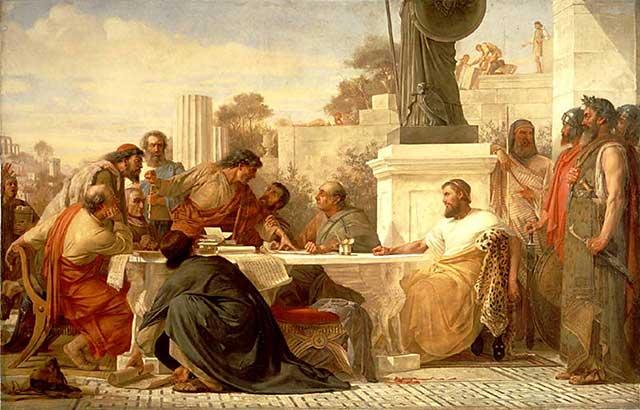 |
| Julian the Apostate presiding at a conference of sectarians, by Edward Armitage, 1875 |
The Roman Emperor, Julian the Apostate, had the aim of continuing the pagan mysteries. Dr. Steiner believed that Julian's expedition into Persia was to gain entrance into the Persian mysteries and those of Manichaeism.
Julian was the one great hope that the ideal of Manichaeism - of marrying the ancient mysteries to Christianity - would be accomplished.
Augustine also failed, but this was his failure to understand the doctrines themselves.
"The aim of Manichaeism was the conquest of evil and of matter by thought. Julian was brought face to face with the deeper implications of the problem of evil and the relation of Christ Jesus to this problem...."
- Quote from Building Stones for an Understanding of the Mystery of Golgotha, Rudolf Steiner, lecture seven.
Dr. Steiner calls the murder of Julian one of the most significant occurrences in history.
_(3309043161).jpg) | |
| St Mecurios killing Julian |
Julian's star knowledge did not pass away however. He was
reincarnated as the famous Danish astronomer Tycho Brahe. Tycho made medicines which relied on his star knowledge - these he gave away for free.
We must incorporate the star knowledge into a future Christianity. And this star knowledge will enter right down deep into the physical world - as Tycho did with his remedies.
There were Sibylline prophecies concerning the destiny of Julian:
In 363, Julian, on his way to engage Persia, stopped at the ruins of the Second Temple in Jerusalem. Julian ordered the Temple rebuilt, which would have proven the Sibylline prophecies wrong. Unfortunately for him, the workers had visions of leaping flames and left the job.
Herzeleide, Parsifal's Mother, was reckoned by Dr. Steiner to be the reincarnated Julian the Apostate. So again we have the connection of the old Mysteries (Julian) melded with Christianity.
He died of a spear wound that reportedly pierced the lower lobe of his liver, the peritoneum and intestines. The perpetrator was said to be a follower of Constantine.
This took place a few days after the Battle of Samarra (26th June 363) in which he was wounded. His reported dying words were: "You have won, Galilean".
More on the murder of Julian:
“MERKOURIOS,” or as it is commonly written in its Latinized form, Mercurius.
"There is a further inscription on the sword of Merkurios that connects it with the Archangel Michael. We will soon see why.
"This first type of Merkurios, showing him standing clothed as a Roman warrior, is the type most commonly found. But there is a second type, found particularly in Coptic Christianity, that shows him mounted on a horse, somewhat as in icons of George the Dragonslayer. But instead of a dragon, there is a fatally-wounded man fallen (often with his horse) under Merkurios, and that man is the Emperor Julian.
Now if we stop to do a little historical math, we can see that Merkurios is said to have died in 250 c.e. The Emperor Julian died in 363 c.e. So we have a gap of 113 years between. Why, then is Merkurios depicted in icons killing Julian?
"The answer lies in another of those fanciful stories common in the study of icons. But first let’s look at an example of the rather violent second type:
"It depicts Merkurios killing Emperor Julian with a lance. At right is a bishop, easily identifiable as such by his garments, particularly the diamond-shaped epigonation worn at his waist. This bishop is St. Basil “the Great.” According to the tale, Basil heartily disliked the Emperor Julian and his “pagan” preferences. Basil went to pray on a mountain with other Christians, and while doing so saw a vision of Mary calling St. Merkurios to her, and telling him to go and kill Julian. So Christian tradition accounts for the death of Julian by saying a mysterious soldier appeared, stabbed Julian with his lance, then disappeared, and that soldier is supposed to be St. Merkurios, sent down from Heaven to do the violent deed."
No comments:
Post a Comment